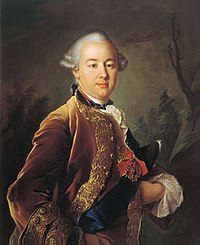| Revision as of 09:39, 25 September 2010 editXanderliptak (talk | contribs)3,323 edits Fixing blazon← Previous edit | Revision as of 03:07, 15 October 2010 edit undoXanderliptak (talk | contribs)3,323 editsNo edit summaryNext edit → | ||
| Line 1: | Line 1: | ||
| {{Emblem | {{Emblem | ||
| |Name = The coat of arms of Count Sheremetev | |Name = The coat of arms of Count Sheremetev | ||
| |Image 1 = |
|Image 1 = | ||
| |Image 1 width = 200 | |Image 1 width = 200 | ||
| |Date of origin = | |Date of origin = | ||
Revision as of 03:07, 15 October 2010

Pyotr Borisovich Sheremetev (Template:Lang-ru) (1713–1788) was a Russian nobleman and courtier, the richest man in Russia aside from the tsar; he was the son of Boris Sheremetev.
When his father Boris died in 1719, tsar Peter promised to be "like a father" to Boris's children, and young Pyotr was brought up at court as a companion to the heir to the throne, who became tsar Peter II.
After a teenage career in the Guards, Sheremetev became a chamberlain to the Empress Anna, and then to the Empress Elizabeth. Under Catherine the Great, he became a senator and was the first elected Marshal of the Nobility. Unlike other court favourites, who rose and fell with the change of sovereign, Sheremetev remained in office for six consecutive reigns. ... He was one of Russia's first noblemen to be independent in the European sense.
He was a lover of art and theater, using his vast wealth to remodel the Sheremetev Palace (known as the "Fountain House") on the Fontanka Embankment and the family estate at Kuskovo, where he collected a gallery of portraits, and to create a famous serf orchestra.
He married Varvara Alekseevna Cherkasskaya, daughter of an important court official, who brought him an expensive dowry.
See also
- Natalia Sheremeteva - his sister
Notes
- Orlando Figes, Natasha's Dance (Picador, 2002), p. 19.